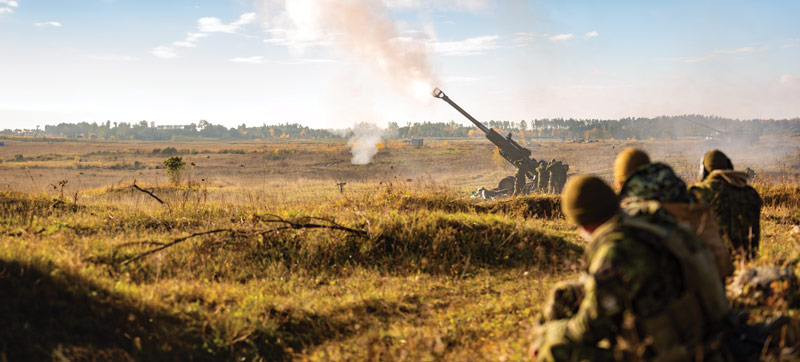
Canadian and Polish soldiers serving with NATO conduct a live fire exercise with a M777 Howitzer in Poland in November 2023.[Captain Joffray Provencher-Canadian Armed Forces Photo/Combat Camera]
In late 2023 and early 2024, the faint sound of the drums of war have been emanating from Europe and the United States. In December 2023, German Defence Minister Boris Pistorius said: “We Europeans must engage more to ensure security on our own continent…we have about 5-8 years to catch up, in terms of armed forces, industry and society.”
Pistorius is not the only one making such statements.
The 2023 Congressional Commission on the Strategic Posture of the United States, for instance, warned that if the U.S. doesn’t begin a serious mobilization, modernization and expansion of its armed forces, it won’t be able to meet the growing geopolitical threat Russia is presenting these days. Not only are the Russians continuing to press their war against Ukraine, but the country’s arms production is increasing—so much so, more than a half million jobs were created in the industry in the past two years. Plus, Russia has increased its military spending, with President Vladimir Putin approving a 22.3 per cent year-over-year increase for 2024, for a total of $500 billion.
There are three obvious possibilities for major war in the next few years. The most serious is the possibility that Russia succeeds in conquering Ukraine, annexes it and pushes on against NATO members Estonia, Latvia and Lithuania, all, like Ukraine, once part of the Russian-dominated Soviet Union. Then there’s the chance for war following a Chinese invasion of Taiwan. Lastly, there’s a risk that should Iran develop the nuclear capabilities it has been pursuing for years, allied militant organizations such as the Yemen-based Houthis, the Lebanon-based Hezbollah and the Gaza-based Hamas might more confidently increase attacks on Israel, the U.S. and other western countries, and such fighting could quickly escalate.
These prospects far outweigh the dangers the West faced during the Cold War when the threat of nuclear confrontation was diminished by the reality of mutual assured destruction.
Rising international tensions come when Canada’s military is almost as small and under equipped as it was in the late 1930s when the fascist powers were marching toward war.
It’s impossible to predict what Russia, China or Iran and its allies might do in the coming years. Historical trends are rarely straightforward. But in the face of the unpredictable Donald Trump possibly being elected for a second term as U.S. president—and given his criticisms of NATO—Europe must take much more of the defence burden on itself than it has at any time since the end of the Second World War.
What about Canada? Rising international tensions come at a time when the country’s military is almost as small and under equipped as it was in the late 1930s when the fascist powers—Germany, Italy and Japan—were marching inexorably toward war. While the Royal Canadian Navy has plans for new surface combatants, submarines and combat-capable supply vessels, most of them won’t be ready for at least 10 years. The Royal Canadian Air Force will begin to acquire F-35 stealth fighters to replace the CF-18s that first entered service in the 1980s, but it won’t get them for at least five years. The government has also ordered the Boeing P-8 maritime reconnaissance aircraft, but that too will take years to arrive. New armed drones are to arrive on a similar timeline.
The army, meanwhile, has been without a dedicated anti-aircraft defence for more than a decade, possesses virtually no modern armour and still relies on the M777 artillery piece from the mid-1990s. All three services are short personnel.
The situation parallels that of 1935 when General Andrew McNaughton, retiring as chief of the general staff, composed a memo for Prime Minister Mackenzie King outlining the deficiencies and sad state of Canada’s military when the fascist powers were clearly preparing for war. King didn’t read the memo for almost two years but, when he did, he reluctantly agreed to begin to increase defence spending. The navy soon acquired several destroyers from Great Britain; Canadian Car and Foundry in Fort William, Ont., (now Thunder Bay) began to produce Hurricane fighter planes; and the army began to seriously consider making Bren guns in Canada under license, purchase trucks and even considered building a Canadian tank—the Ram.
Even so, Canada went to war in 1939 almost completely dependent on British equipment. It took years to establish a respectable armed forces, and given the current cut to a modest national defence budget, Canadians can expect more military shortfalls.
Perhaps Senator Raoul Dandurand was correct when he declared at the League of Nations in the early 1920s that Canada “lives in a fireproof house, far from flammable materials.”
Let’s hope for Canada’s sake that’s still true a century later.
Advertisement























